Pete Walker, master of British exploitation
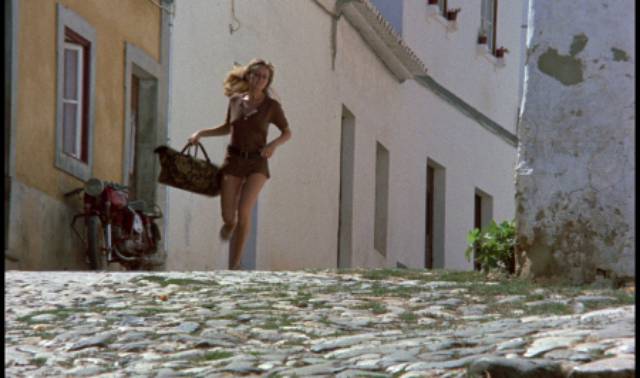
I’ve recently revisited most of the work of Pete Walker, perhaps the foremost British exploitation filmmaker from the late ’60s to the end of the following decade. Before embarking on features, he had been a very successful producer of sexploitation shorts and, not surprisingly, his initial attempts at longer-form movies were of the same ilk. But making the move from private clubs to mainstream cinemas raised difficulties with the censors and Walker quickly took a different path, into thrillers and horror – not because of any particular liking for those genres, but rather because they offered a better chance of commercial success. This was a practical decision because much of his work was self-financed and sold off to distributors after completion. The course of his career, then, was similar to others working in exploitation – the likes of Herschell Gordon Lewis, for instance, who also veered from sexploitation to horror. But as a business-minded filmmaker, Walker also bore some resemblance to Roger Corman, whose canny choices were rooted more in his understanding of what attracted an audience than any innate commitment to a particular genre.
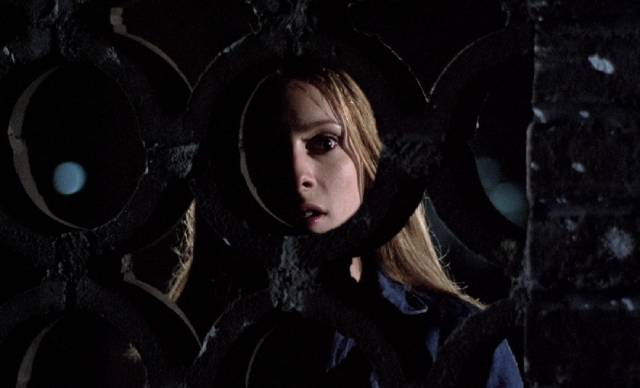
Walker made sixteen features in sixteen years, a pretty good record for an independent low-budget filmmaker during a rocky period in British film production; most of those movies made money despite frequently facing critical contempt. He eventually gave up producing and directing (ironically after making his only studio-backed film with major genre stars, the horror-comedy House of the Long Shadows [1983]) and went into property development. And yet, since retiring from filmmaking, his work has gradually undergone re-evaluation and is recognized now not only for its transgressive genre elements, but more significantly for its satirical and often astute view of social issues and, most particularly, the hypocrisy which is at the core of Britain’s deeply ingrained class consciousness.
I’ve just watched thirteen of Walker’s movies back-to-back thanks to a pair of new box sets from 88 Films and an older BFI Blu-ray. Three of these were new to me, the rest I’d seen at least once before, and in some cases several times. Rather than watching them in chronological order, I went set by set starting with the seven-disk The Flesh and Blood Show, then on to the four-disk Pete Walker Sexploitation Collection, finishing with the Flipside Man of Violence/The Big Switch double-feature Blu-ray (also available in a two-disk set from 88 Films) – not the best way to track his progress, perhaps, but privileging his best-known and most popular work, the horror films of the ’70s.
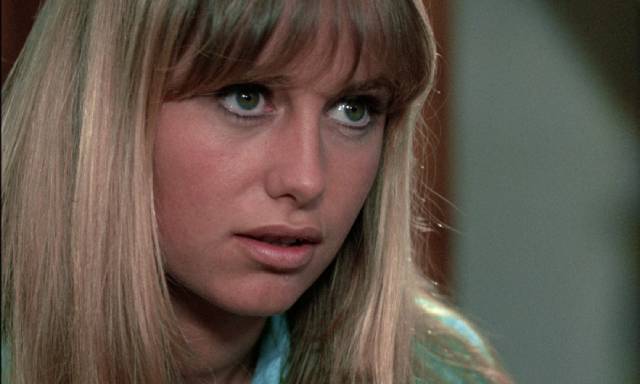
This cycle began with Die Screaming, Marianne (1971), a thriller with roots in the same soil as Hammer’s ’60s psycho-thrillers, and resembling the Italian thrillers of the same period which eventually led to the giallo. The story involves a young woman in peril – Susan George as Marianne – a dysfunctional family with an inheritance hanging in the balance, and various characters who may not be who they seem. Given Walker’s background in sex films, he managed to get a fairly impressive cast for this project. Although just twenty, George already had a well-established career in television and features (and just after this, the same year, achieved international notice in Sam Peckinpah’s Straw Dogs). Barry Evans was a familiar face on television, particularly from the popular Doctor in the House comedy series (1969-70), and had had a hit with Clive Donner’s sex comedy Here We Go Round the Mulberry Bush (1968). Some gravity was added by Leo Genn, a character actor whose career went back to the mid-’30s, who played Marianne’s stepfather, a judge living in exile in Portugal after his judicial career ended in disgrace. There are also hints of an incestuous relationship between the judge and his daughter Hildegard, played by Judy Huxtable, whose brief career also spanned television and features.
There are still traces of Walker’s sexploitation background here – a hint of farce in a mix-up at the registry office when Marianne is inadvertently married to Eli (Evans) rather than his friend Sebastian (Christopher Sandford), a fortuitous error it turns out because Sebastian is actually working for the judge; and that suggestion of incest – but he’s obviously feeling his way towards something more suspenseful and violent. Though not entirely successful – the pace is rather leisurely – the cast and sunny locations work to the movie’s advantage.
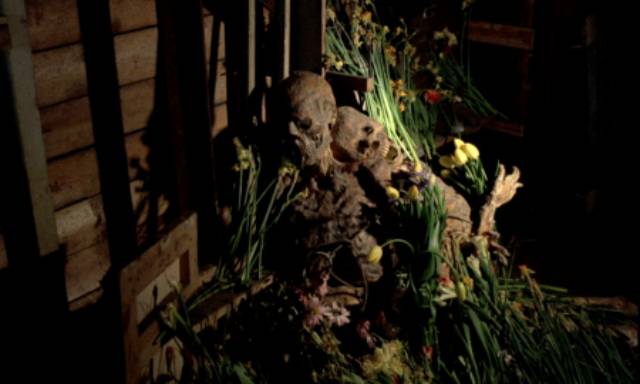
After one more sex film – Four Dimensions of Greta (1972), which included some 3D flashbacks – Walker moved on to his first outright horror movie, The Flesh and Blood Show (1972), which made use of a familiar set-up to stage a series of violent murders. There are obvious echoes of the giallo, and while there are no real surprises, Walker handles things efficiently while spicing it up with a 3D flashback sequence which eventually explains the reasons for the murders occurring during rehearsals for a new theatre revue. The biggest advantage the production had was access to the old Brighton Pier with its theatre perched above the sea. Walker milks this location for all its worth and stages some effective murders, although again pacing is a bit slow, with a lot of time spent on bickering (and sex interludes) among the theatre troupe’s members, played by Ray Brooks, Jenny Hanley, Robin Askwith, Luan Peters, Judy Matheson and others.
A crucial step forward occurred after Walker’s next movie (a comic-strip adaptation called Tiffany Jones [1973]) when he connected with film journalist and critic David McGillivray, who proved to be the ideal person to bring out Walker’s thematic interests. With their first collaboration, House of Whipcord (1974), Walker really found his footing; well-paced, with an excellent cast committing fully to its sordid narrative, this film is the first to fully express Walker’s jaundiced view of Britain’s moribund class system and the hypocrisy which kept it afloat. Dark, grimly funny and at times genuinely shocking, it was a box office success while receiving appalled disdain from most critics, a pattern repeated over the next few years with each new release.

Personally conservative, Walker nonetheless disliked the reactionary opinions – and actions – of people like Mary Whitehouse and the National Festival of Light which since the ’60s had been trying to fight the tide of permissive attitudes which they felt were destroying the country. These people advocated for strict censorship of television, movies, and books and harsher laws and punishments for anyone who offended their sense of propriety. (Their biggest success came with the Video Recordings Act passed by the Thatcher government in the early 1980s.) In McGillivray’s script, based on Walker’s story idea, they were embodied in Mrs. Margaret Wakehurst (Barbara Markham) and retired Justice Desmond Bailey (Patrick Barr), with an assist from Matron Walker, the first, defining role for Walker’s favourite actress Sheila Keith. These people, disgusted with what has happened to society, have bought themselves an old prison to which they bring kidnapped young women who have transgressed in some way, subjecting them to harsh punishment up to and including hanging.
Model Julia (Ann Michelle) was arrested for public nudity when she was involved in a magazine photo shoot in a city park, the small fine a minor inconvenience compared with the publicity the magazine garnered. At a party, she’s approached by a mysterious man who intrigues her and, on short notice, invites her to the country to meet his family. She ought to be more suspicious as his name is Mark E. Desade (Robert Tayman). His reckless driving does provoke anxiety, but she’s still not suspicious enough when they arrive at the grim building and can’t believe she’s in real danger until it’s too late; forced to strip by Walker and undergo a humiliating examination before being given drab prison clothes and locked in a cell, she finally realizes she’s in the hands of a sadistic bunch who justify what they’re doing as enforcing the morality which has made Britain great.
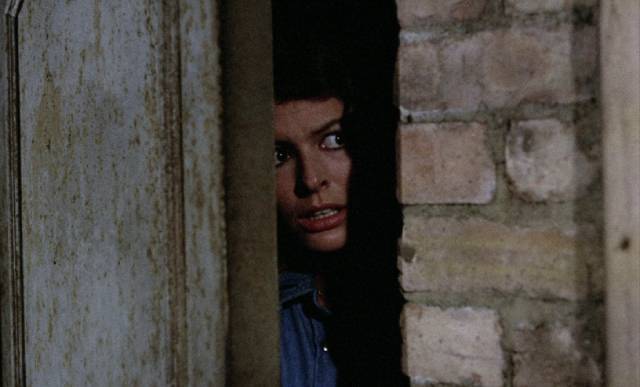
The film actually begins with Julia fleeing through woods, hurt and desperate, finally making it to a road where she’s picked up by a helpful truck driver who, seeing that she needs serious help, takes her to what he believes is a clinic … which, unfortunately, turns out to be the private prison. The bitter irony is compounded because her escape is the final infraction and she’s sentenced to the gallows. Here, Walker’s work takes a very dark turn which is carried through his other collaborations with McGillivray; very bad things happen to characters the audience likes. But while the horror is genuine, there’s also a dark strain of humour in the treatment of the villains; Mrs. Wakehurst’s irritable impatience with the senile Justice Bailey, who no longer understands what papers he’s signing or how severe are the punishments he’s sanctioning, is like the irritation between an old married couple over little personal annoyances. The performances of Markham, Barr, Keith and Dorothy Gordon as Bates, the matron who’s less committed than Walker to the institutional brutality, are a big leap forward compared to those in the earlier movies, further confirmation that Walker had finally found the right material to suit his particular talents.
This impression is confirmed by his next two collaborations with McGillivray, which with House of Whipcord form a loose trilogy which paints the core social institutions of English society as monstrously corrupt. Following the law, they tackle the medical establishment, the family and religion. Frightmare (1974) and House of Mortal Sin (1976) also cemented Sheila Keith’s position as Walker’s demented alter-ego with two more larger-than-life characters whose monstrousness nonetheless contains a sympathetic undercurrent.
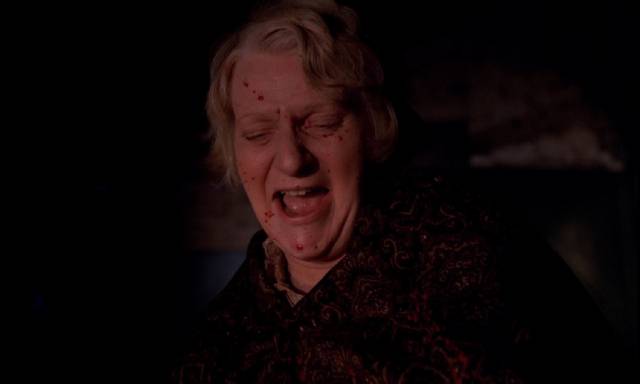
In Frightmare, Keith plays Dorothy Yates, a woman whose taste for human brains saw her convicted and sentenced to years in an asylum for the criminally insane, along with her husband Edmund (Rupert Davies), who claimed to share her illicit tastes not because he actually ate brains himself but because he loves her and wanted to remain close. Years later, doctors deem her cured and the couple are released and move into a remote farmhouse. But Dorothy’s appetites are as strong as ever. Edmund’s daughter Jackie (Deborah Fairfax) tries to manage the situation by surreptitiously delivering packages a cow brains, trying to pass them off as human, but Dorothy isn’t fooled; using ads offering Tarot readings, she lures people to the house and kills them, drilling their skulls open and hiding the bodies in the barn after eating the fresh brains.
The film’s implicit criticism of an establishment which releases dangerous maniacs back into the community is the closest the trilogy comes to a conservative position, but Walker and Keith manage to evoke a lot of sympathy for Dorothy, a victim of her own uncontrollable impulses, and there’s a note of tragedy in Edmund’s devotion to her, his willingness to voluntarily share her madness out of love. The bleak ending seems inevitable, affirming the bonds of family against society’s censure of Dorothy’s cravings.
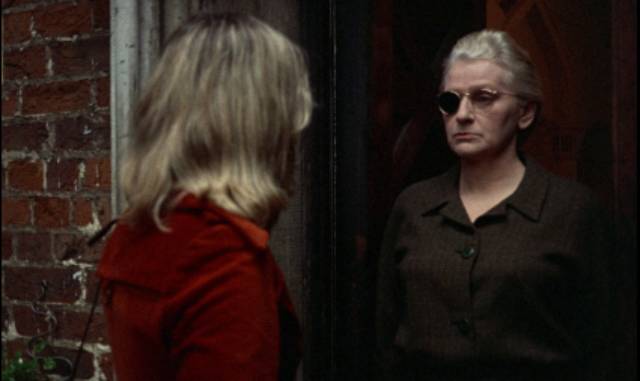
In House of Mortal Sin, Keith is less sympathetic as the one-eyed housekeeper for Father Xavier Meldrum (Anthony Sharp), a Catholic priest whose repressed sexuality has deranged him to the point of committing murder to punish sinners. It’s late in the film when we finally learn the backstory of Miss Brabazon, the woman rejected decades earlier when Meldrum’s mother pushed him to abandon her and enter the priesthood. Unable to let go, Miss Brabazon has devoted her life to serving him, the pair sharing a house beside the church, constant mutual reminders of what was given up and lost, sinking into a kind of shared madness fuelled by unexpressed sexual longing.
While Brabazon finds release in tormenting Meldrum’s mother (Hilda Barry), bed-ridden and mute after a stroke, he finds release in recording the confessions of girls and young women and blackmailing them (The Confessional was an alternate title) – the film begins with a desperate teenager committing suicide after a session with the priest. Although not religious, Jenny Welch (Susan Penhaligon) finds herself in the confessional after her latest breakup with an abusive boyfriend, her visit drawing Meldrum into her life with increasingly violent consequences.
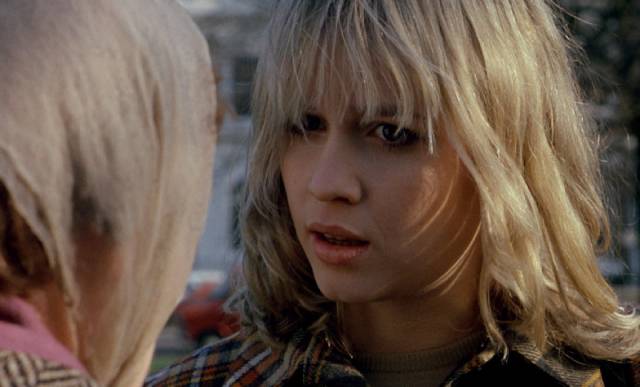
As the bodies begin to pile up, in a parallel narrative Meldrum’s protege Father Bernard Cutler (Norman Eshley) finds himself questioning the church’s unhealthy attitudes towards sexuality as he rekindles a relationship with Jenny’s sister Vanessa (Stephanie Beacham), coming close to renouncing his vows until the downbeat ending leaves him defeated and submissive. The film’s depiction of the hypocrisy and corruption of organized religion is perhaps the most fully realized treatment in Walker’s work of the social institutions which distort and destroy people’s lives. After capping the “trilogy” with his most accomplished film, Walker’s final four movies didn’t manage to reach these heights.
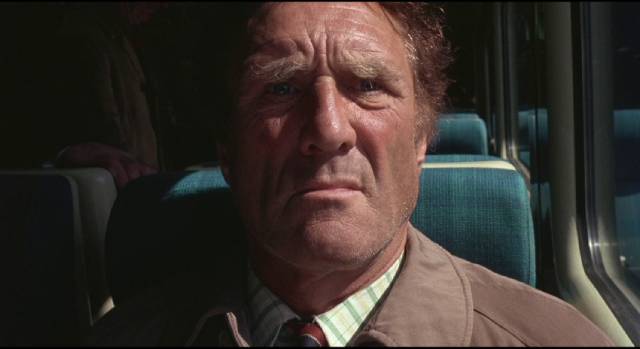
Schizo (1976), again written by McGillivray (with some uncredited work by former collaborator Murray Smith), as suggested by the title, is a throwback to those Psycho-influenced thrillers of the ’60s. When ice-skater Samantha (Lynne Frederick) gets into the papers, a dour man named William Haskin (Jack Watson) sees the article about her upcoming marriage to Alan (John Leyton), packs his bag and heads for London. Samantha starts to receive menacing phone calls and Haskin lurks around spying on her. No one believes her when she claims that someone from her past is threatening her, but soon people are being killed. The final-act twist can be guessed fairly early, so the movie feels as if it’s going through some obligatory motions, but Walker manages to maintain interest with a repeated giallo-esque flashback to violent childhood trauma and a good cast who, as in his other films, play their parts with conviction.
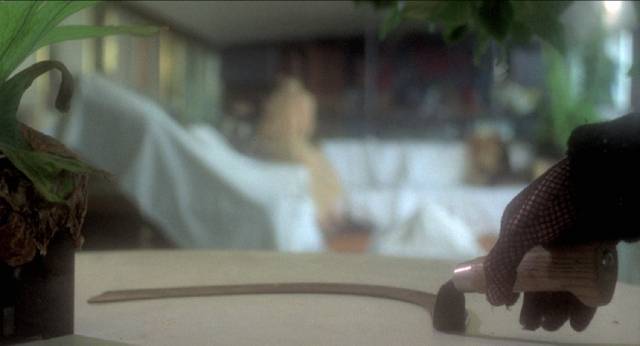
The Comeback (1978), with Murray Smith resuming his place as scriptwriter for the first time since Four Dimensions of Greta, is the silliest of Walker’s horror movies, an implausible psycho/slasher story which asks the audience to believe that crooner Jack Jones is Nick Cooper, a former great star whose career has faded due to his marriage to a controlling woman. But now he’s divorced and determined to make his comeback by recording a new album. As he settles into a big country house rented by his agent Webster Jones (David Doyle taking a break from his long run as Bosley in Charlie’s Angels), where he’s looked after by the vaguely sinister Mr. and Mrs. B (Bill Owen and Sheila Keith), he’s unaware that his ex-wife Gail (Holly Palance) is dead and decaying in his London flat, the victim of a savage attack by a masked killer.
Back at the mansion, Nick’s nights are disturbed by screams and visions of his dead wife – eventually leading to a breakdown and hospitalization. Even after the climactic reveal of the killer’s identity and motive, it seems that he’s suffered permanent psychological damage. Jones does a decent job in the kind of role usually assigned to a female lead, but his mellow singing style (he was probably best-known for the Love Boat theme) seems unconvincing for a performer whose fans are so passionate that they might commit suicide when he got married. It’s interesting to speculate how the movie would have turned out if Walker had managed to get his first choice for the role, Bryan Ferry.

Walker set aside horror after this effort and returned to sexploitation. The final film in 88 Films’ second box set is Home Before Midnight (1979), which is actually more queasily suspenseful than The Comeback. Band member Mike Beresford (James Aubrey) picks up a couple of hitchhikers and ends up sleeping with one of them who becomes something of a groupie. What he doesn’t realize at first is that Ginny (Alison Elliot) is actually an underage schoolgirl. She’s fairly open with her parents Harry (Mark Burns) and Susan (Juliet Harmer) that her new boyfriend is a bit older, but they don’t seem particularly concerned. But things get complicated when Mike learns how old she actually is – and irresponsibly doesn’t end the relationship.
When the band appear on a television talk show and Harry and Susan realize who the new boyfriend actually is, they’re suddenly appalled. Harry insists that they call the police and report that Ginny has been raped by Mike. Under pressure, Ginny goes along with the accusation and Mike finds himself in trouble with the law. Rather stupidly, he hangs around outside her school looking for a confrontation; this just looks like intimidation to the school staff and his legal troubles deepen and he’s eventually put on trial for rape, which gets him kicked out of the band and shunned by former friends.
Mike’s an irresponsible idiot, but the film seems to think he’s the victim – after all, Ginny is precocious and looks much older than fourteen. It’s her parents who are the bad guys, with Ginny herself a duplicitous girl because she lies about him having forced himself on her. All he did was enjoy a consensual sexual relationship, but society’s outmoded rules end up ruining his life (although he is acquitted at the trial).
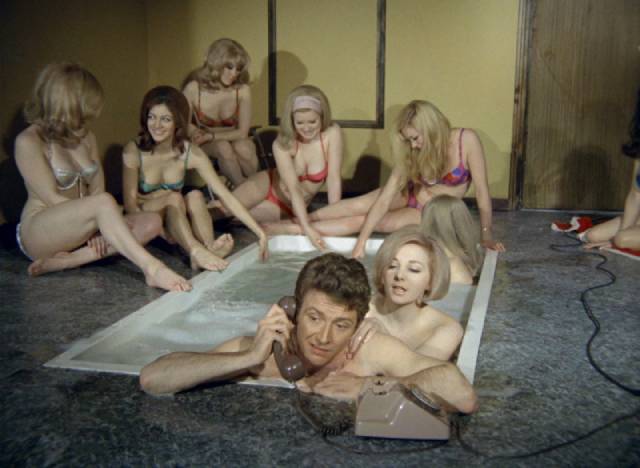
By the end of the ’70s, the attitudes of the ’60s when Walker was making his sexploitation movies, seemed much more problematic, ending the second set on a rather sour note. But it begins with fluffy comedies more akin to Benny Hill and the Carry On movies, though with more nudity. After all the short nudie movies, Walker stretched a little with For Men Only aka I Like Birds (1967), an intermediate-length 43-minute comedy about a fashion reporter who takes a job with a moral crusader publisher only to discover that the upright paper is just a cover for the real moneymaking business of nudie magazines. The writer is surrounded at his boss’s country estate by scantily-clad women, which is awkward when his fiancee shows up.
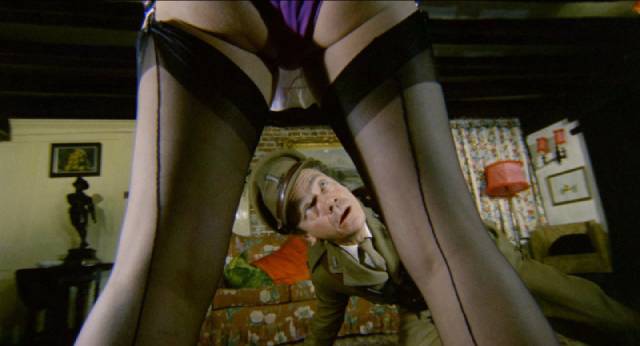
School for Sex (1969) is much the same, though twice as long, a mild comedy to justify a lot of time spent ogling scantily-clad, sometimes naked female bodies. An aristocrat, after a trial for fraud, opens a “finishing school” to train women in how to please men so that they can snag wealthy husbands. Times have definitely changed, since what amounts to sex trafficking – the women are paroled prisoners provided by a corrupt bureaucrat – is treated as an amusing lark.
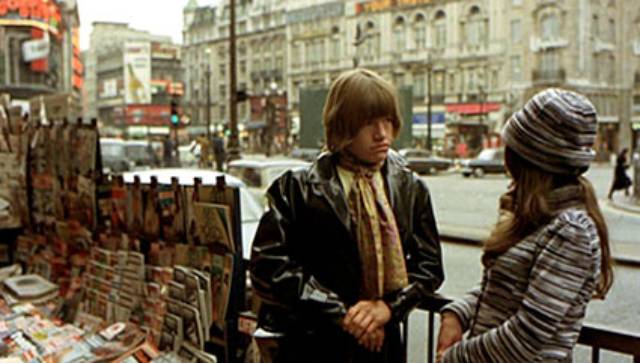
By the end of the decade it seems that Walker had realized this kind of work had become a dead end and, with his first collaboration with writer Murray Smith, he made one of his best films, taking as subject the business he’d been involved in. Cool It, Carol! (1970) begins as another sex comedy, but inexorably morphs into something darker – until Walker eventually takes pity on his characters and pulls back for, if not quite a happy ending, at least an avoidance of the bleak ending which had seemed inevitable.
Carol (Janet Lynn) and her kind-of boyfriend Joe (Robin Askwith in his first starring role, and first of three movies for Walker) live in a small provincial town without many prospects. When Joe, fed up with working for the local butcher, floats the idea of heading to London, Carol jumps at the chance to get away … though it seems Joe was really just fantasizing, making up a job offer for a position at a high-end car dealership. Carol has her own fantasy as she had won a prize at a local beauty contest judged by a minor celebrity named Rod Strangeways (comedian-singer Stubby Kaye); she believes he’ll be able to get her into the modelling business. With the blessing of her parents, she and Joe take the train to the big city.

Inevitably things don’t go as planned. Joe doesn’t have a job and can’t find one; Carol is told she’s too short for modelling and is nudged towards posing for nudie magazines. With money running low, she acquiesces, but even that line of work doesn’t pay enough to keep the pair afloat – and Joe begins to push her towards prostitution. After all, sex is just a bit of fun, so why not make some money doing it? Eventually she finds herself drawn into making the kind of short movies Walker began his career with – is it hypocritical that he depicts this business in a sour way? Probably, but the sequence in which Carol and Joe are paid to perform for the camera has an uncomfortable, grimy authenticity.
Although Carol does manage to make enough money to keep her and Joe in relative economic security, the couple eventually realize that this is not the life they had in mind and they pack up and go back home, less naive certainly, but still without any appealing prospects. Although the movie suggests a decisive turning away from the kind of work Walker had been doing for the past decade, he did make one more sexploitation feature (Four Dimensions of Greta, not included in the set); but after making Carol, he immediately aimed for the mainstream with Die Screaming, Marianne.
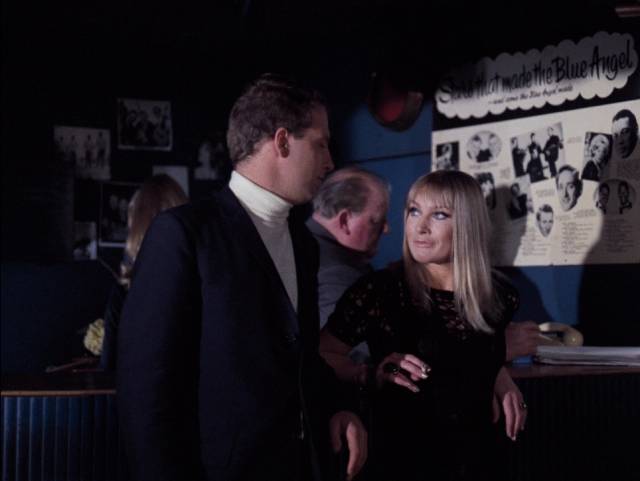
However, the transition wasn’t quite as clear-cut as this. After a decade of sexploitation, Walker spent several years feeling his way towards something more mainstream; in between For Men Only, School for Sex and Cool It, Carol!, he tried his hand at a couple of crime thrillers. The Big Switch (1968) had plenty of nudity while nonetheless attempting to tell a story about gangsters with a convoluted plot which involves framing playboy John Carter (Sebastian Breaks) for the murder of a woman he picks up in a disco. Carter and a woman named Karen (Virginia Wetherell) are dragged around the country, beaten up and held prisoner without knowing why, though the couple are forced to pose for sleazy photos. It turns out that they’ve been chosen as models in an elaborate plan to transform a gangster via plastic surgery so he can re-enter the country. A bit far-fetched, but realism isn’t the point and Walker ends it all with a shoot-out on Brighton Pier on a cold winter day.
The BFI Flipside Blu-ray includes the 68-minute British cut, plus the 77-minute export version, which naturally includes more exploitable nudity.
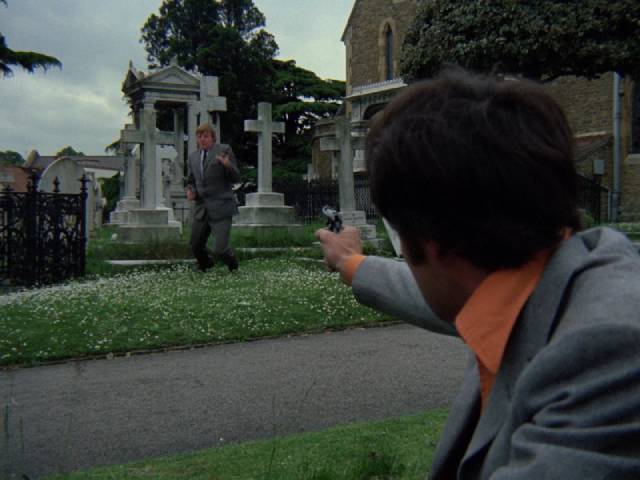
Two years later, Walker made the more ambitious Man of Violence aka Moon (1970), a very convoluted caper movie with location shooting in England and Tunisia. Gun-for-hire Moon (Michael Latimer) finds himself caught between rival gangsters who are both after a stash of gold stolen during a revolution in a Middle Eastern country. There are also various political factions after the loot, with no one’s loyalties easy to discern. It’s all Moon can do to stay alive since everyone thinks he’s working for someone else and they all want him dead. Along for the ride is Luan Peters who thinks she’s been recruited by Special Branch, though apparent copper Burgess (George Belbin) isn’t quite what he seems.
In trying to emulate the international thrillers which followed on the heels of the Bond movies, Walker managed to make an entertaining film which seems to mock the entire genre. Man of Violence was an attempt to move in a new direction which even Walker didn’t seem to take too seriously, but he was gradually honing his skills – which led to the much more accomplished Cool It, Carol! later that year and Die Screaming, Marianne the following year, which finally took him into the genre where he would do his finest work over the next half-decade.
In various interviews included in the two 88 Films sets, Walker comes across as a self-aware, engaging figure who views his own work with a degree of amusement; when he was making these movies, he saw them from a business perspective – each one had to make enough money to finance the next – and he’s obviously pleased that decades later people are still watching them, not simply as entertainment but also as worthwhile expressions of social commentary. While his work is uneven, at his best he was an astute observer of the times with a disdain for the establishment and its deeply embedded hypocrisy.
*
NOTE October 25: By an odd coincidence, Jack Jones, star of The Comeback, died on Wednesday, the day this was posted. He was 86 … and not surprisingly, Walker’s movie wasn’t mentioned in the NY Times obituary.
Comments
Only one of these on Tubi… Man of Violence. Plus one not mentioned: Encore. Will give them a look.
Encore is apparently an alternate title for The Comeback.